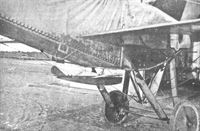
| Самолеты (сортировка по:) | |||||
| Страна | Конструктор | Название | Год | Фото | Текст |
Siemens-Schuckert Torpedo glider

|
Страна: Германия Год: 1915 Планер
|
| Siemens-Schuckert - R-II - R-VII - 1915 - Германия | <– | –> | Siemens-Schuckert - D.I - 1916 - Германия |
 |
J.Herris - Siemens-Schuckert Aircraft of World War I /Centennial Perspective/ (12) |
| SSW Biplane Torpedo Glider Guided Missile |
 |
J.Herris - Siemens-Schuckert Aircraft of World War I /Centennial Perspective/ (12) |
| SSW Monoplane Torpedo Glider Guided Missile |
 |
J.Herris - Siemens-Schuckert Aircraft of World War I /Centennial Perspective/ (12) |
| After being modified to eliminate its protruding belly, the SSW Bulldog, powered by one of the first 110 hp Siemens-Halske Sh.I counter-rotary engines, was used to launch scale gliders to develop shapes for the SSW guided missile program. |
 |
J.Herris - Siemens-Schuckert Aircraft of World War I /Centennial Perspective/ (12) |
| Another view of a test glider mounted under the modified, rotary-powered SSW Bulldog before a test launch. |
 |
J.Herris - Siemens-Schuckert Aircraft of World War I /Centennial Perspective/ (12) |
| Siemens test glider in 1915. |
 |
J.Herris - Siemens-Schuckert Aircraft of World War I /Centennial Perspective/ (12) |
| One of the early larger gliders hanging from the Parseval P.IV airship.The configuration is similar to the smaller gliders. The internal guidance package was powered by a battery, and later by a propeller-driven dynamo. Guidance signals were transmitted by thin wires several kilometers long. |
 |
J.Herris - Siemens-Schuckert Aircraft of World War I /Centennial Perspective/ (12) |
| Experimental glide-bombs in the Biesdorf airship shed in December 1915. Type 1b, the most common, had a wing area of 17.2 ft.2 and weighed up to 150 lb. A Type 1c is at far left. |
 |
J.Herris - Siemens-Schuckert Aircraft of World War I /Centennial Perspective/ (12) |
| One of the larger test gliders attached to an airship. The guidance system Siemens developed was command guidance by means of wires that unspooled from the glider. |
 |
J.Herris - Siemens-Schuckert Aircraft of World War I /Centennial Perspective/ (12) |
| As the gliders were enlarged, they were built as biplanes. Successful guided flights against ground targets were made from an airship in 1916. |
 |
J.Herris - Siemens-Schuckert Aircraft of World War I /Centennial Perspective/ (12) |
| SSW torpedo-glider #2, weighing 300 kg, was successfully dropped from airship Z.XII in April 1917 after more than 75 glide-bombs were tested at Biesdorf. The cable spool is between the body and the upper wing. |
 |
J.Herris - Siemens-Schuckert Aircraft of World War I /Centennial Perspective/ (12) |
| SSW glide-bomb #66 on the launching track at the SSW cable works. In October 1916 the 3.5 m long torpedo was first successfully released above the water of the Spree Canal. |
 |
J.Herris - Siemens-Schuckert Aircraft of World War I /Centennial Perspective/ (12) |
| Two SSW torpedo gliders suspended below an airship, probably Zeppelin L.35, which was used for testing. |
 |
J.Herris - Siemens-Schuckert Aircraft of World War I /Centennial Perspective/ (12) |
| An Albatros D.III and a 500 kg SSW torpedo glider beneath Zeppelin L.35 on Jan. 26, 1918. This was the first time an airplane was launched from an airship. |
 |
J.Herris - Siemens-Schuckert Aircraft of World War I /Centennial Perspective/ (12) |
| SSW torpedo-glider #7 showing the torpedo in flight mode at left. On August 2,1918 this glider flew 7.4 km after being released from Zeppelin L.35 at an altitude of about 1,200 meters. Just after being commanded to turn into the target at about 60 meters altitude, the 7.4 km long guidance wire broke and the glider spun and crashed near the target. This was the last torpedo glider launched from a Zeppelin. |
 |
J.Herris - Siemens-Schuckert Aircraft of World War I /Centennial Perspective/ (12) |
| SSW torpedo-glider #7 showing the torpedo in release mode. |
 |
G.Haddow, P.Grosz - The German Giants /Putnam/ |
| This SSW monoplane torpedo glider weighed 1,000 kg and was developed after the final Zeppelin test in August 1918. The monoplane torpedo glider was intended for use from Zeppelins and, with its lower profile, could also be carried under large bombers. The pod on top of the body carried the spool of guidance wire. Power for the controls was provided by the wind-driven generator mounted above the nose, behind which can be seen the container for the spool of guide wire. Further Zeppelin tests were planned but the Armistice intervened. |
 |
J.Herris - Siemens-Schuckert Aircraft of World War I /Centennial Perspective/ (12) |
| This advanced monoplane torpedo glider had a dynamo in the tail to power the guidance system and the control wires ran out through the hollow dynamo shaft. |
 |
J.Herris - Siemens-Schuckert Aircraft of World War I /Centennial Perspective/ (12) |